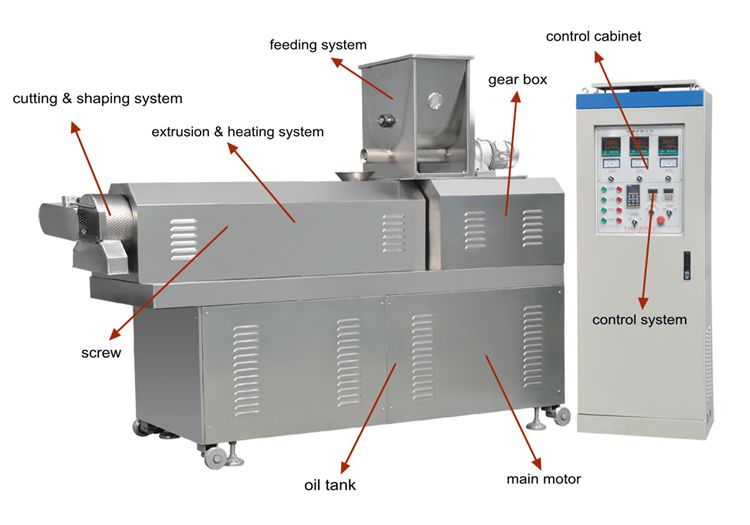Tel:+86-15264102980 Mob:+86-18660429170 Whatsapp: 8615264102980
The Twin screw food extruder is a kind of multi screw food extruder. It is developed on the basis of the single screw food extruder. In the barrel of the twin-screw extruder, two screws are placed side by side. Therefore, it is called a twin screw extruder.

1.Classification
According to the relative position of the screw, it can be divided into meshing type and non-meshing type, and the meshing type can be divided into partial meshing type and full meshing type;
According to the rotation direction of the screw, it can be divided into two types: co-rotation and reverse rotation, and reverse rotation can be divided into two types: inward and outward. The properties of the pressure zone of the co-rotating twin-screw are different. The material is rotated by the screw in the inner cavity of the sleeve to produce a high pressure zone and a low pressure zone.
2.Principle of action
Obviously, the material will flow from the high-pressure zone to the low-pressure zone in two directions: one is that the wear of the square screw decreases as the screw rotates. The material is conveyed, sheared, mixed and heated by the barrel shell. , It is matured under the action of high pressure, and finally squeezed out of the barrel.
The counter-rotating twin-screw food extruder generally uses two screws with the same size but opposite thread directions. The difference between inward rotation and outward rotation lies in the position of the pressure zone. The pressure generated by the inward rotation of the twin screw is high and low. When the material passes through the twin screw, an extremely high pressure will be generated at the inlet, causing difficulty in feeding. This inward and reverse rotation type is rarely used; the pressure generated by the outward rotation of the twin screw is high and low, which is conducive to feeding. However, compared with the reverse rotation and the same rotation, the C-shaped material flow formed in the screw cannot move from one screw to the other, the mixing degree of the material is significantly reduced, and its self-cleaning ability does not rotate in the same direction. The twin screw is effective and stable.
3.Double screw food extruder Features
The Double-screw extruder has the advantages of strong adaptability, sliding conveying and self-cleaning, but its structure is complicated, the investment cost is high, and the corresponding maintenance and operation costs are also high. Therefore, twin-screw snacks extruders are generally used in the production of high value-added aquatic products and pet feed, such as the production of eel, turtle and juvenile feed, because the prices of these products on the market are sufficient to repay the twin-screw technology. The cost of manufacturing products; other special aquatic feeds such as fine aquatic feeds (0.8-1.5mm in diameter), high-fat aquatic feeds, and feeds with small production volumes but often changing formulations also need to be produced with twin-screw extruders.
The development of double-screw pet food extruder is relatively late in China. For the medium-sized twin-screw extruder, due to the large range of raw material characteristics, the screw speed needs to be adjusted in a larger range, because its working principle is different from that of single The double screw extruder has a big difference in the specific structure, especially the arrangement of the barrel, screw, thrust bearing and gear box is more complicated, resulting in an increase in equipment cost. The left and right C-shaped material flows are formed along the inner wall of the sleeve, which is the main flow of the material; the other is the reverse flow through the gap of the screw meshing part. The reason for the reverse flow is that the left screw pulls the material into the meshing gap, and the right screw pulls the material out of the gap, which causes the material to advance in the shape of "∞" and change the direction of material flow. This not only contributes to the mixing and homogenization of materials, but also causes grinding (ie shearing) and rolling between the tooth grooves of the screw, resulting in a calendering effect, which is much smaller than the reverse screw calendering effect .
Tel:+86-15264102980
Mobile:+86-18660429170
Email: kevin@fldmachine.com
Whatsapp: 8615264102980


Copyright 2025 © Jinan FLD Machinery CO.,LTD All Rights Reserved.